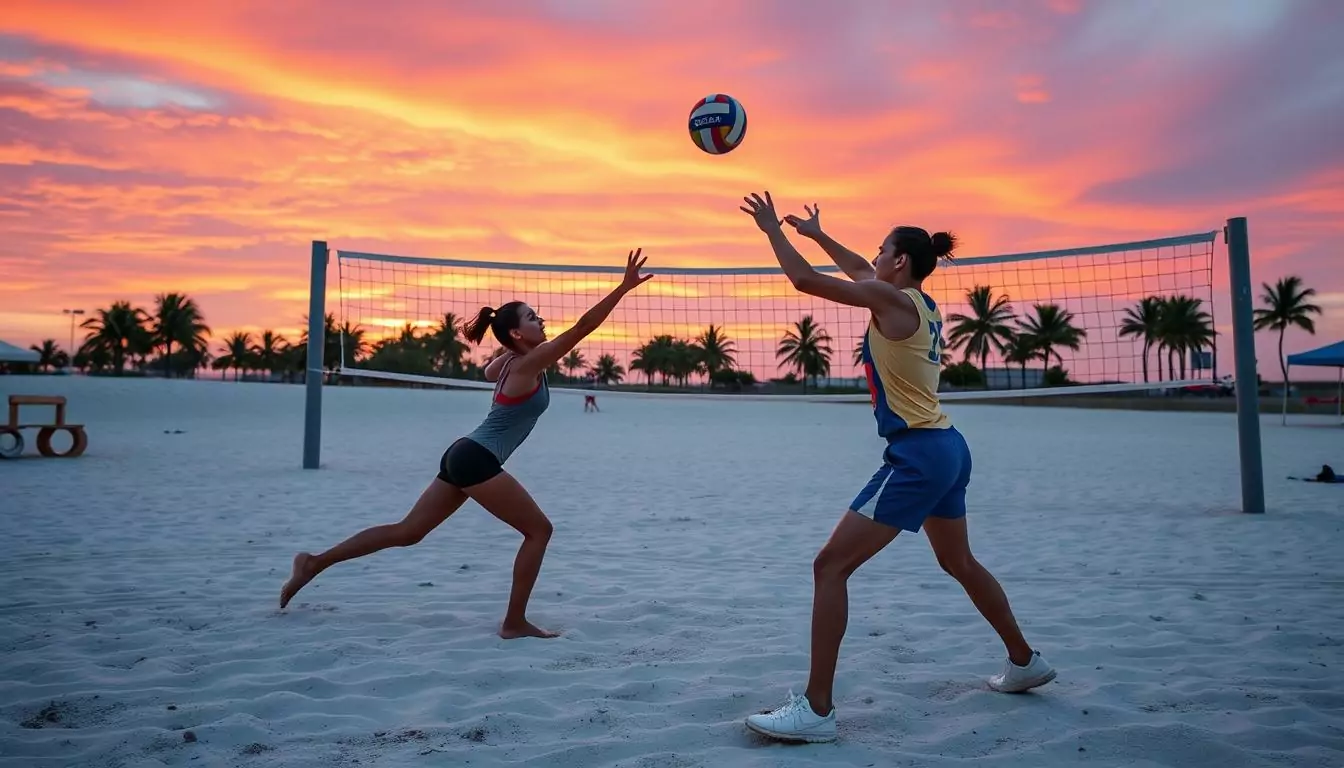Did you know that just 10 minutes of volleyball drills with a partner can boost serve-receive accuracy by 15%? These drills are key for improving skills and building a strong team. As a seasoned player, I’ve seen how practicing with a partner can change the game.
Key Takeaways
- Volleyball partnership drills enhance teamwork, communication, and overall game proficiency.
- These drills target a wide range of skills, including agility, power, technique, and situational awareness.
- Consistent practice with a partner can lead to measurable improvements in serving accuracy, passing control, and setting precision.
- Collaboration and trust-building are at the heart of these drills, preparing players for effective gameplay.
- Drills can be adapted to cater to players of all skill levels, from beginners to seasoned varsity athletes.
We’ll explore a variety of volleyball drills that can improve your game and team connection. These exercises are great for coaches, players, and volleyball fans. They will be a valuable part of your training.
Discover the complete guideto high school volleyball. It’s packed with exercises to boost your team’s performance.
Importance of Partnership Drills in Volleyball
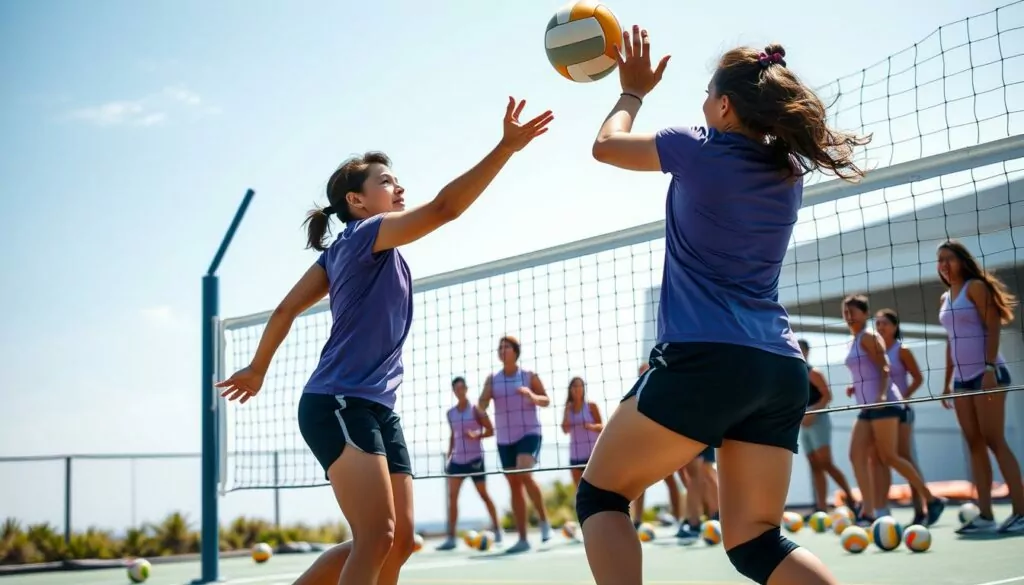
Volleyball is a team sport that needs players to work together smoothly. Partnership drills help build trust and improve communication. They make teammates better at working together during games.
Building Trust on the Court
Trust is key for successful volleyball partnerships. Through teamwork, players learn to anticipate each other’s moves. This builds a strong bond and trust, helping them rely on each other in tough game moments.
Enhancing Communication Skills
Good communication is vital in volleyball. Quick reactions and teamwork can win or lose a point. Partnership drills help players improve their communication, making them better at moving together and executing strategies.
“Passing in volleyball is critical, with no skill having a greater impact on a team’s success.” – Terry Liskevych
By focusing on partnership drills, volleyball players can grow their trust, communication, and overall performance.
Basic Drills to Get Started
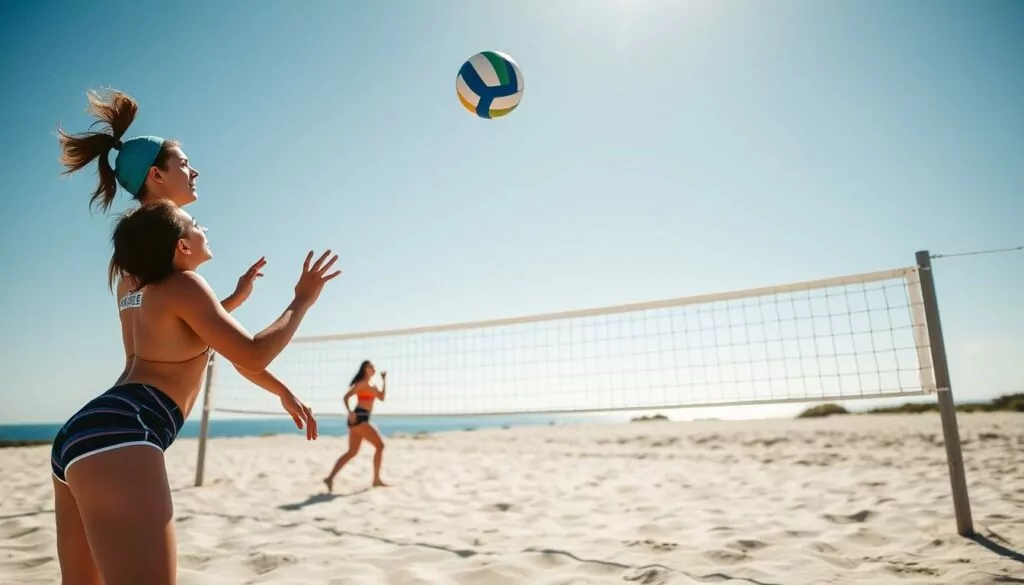
Working with a teammate is a great way to improve your volleyball skills. By doing paired volleyball workouts and collaborative volleyball routines, you can get better at passing, setting, and defense. Let’s explore some basic volleyball duo training drills to help you start.
Partner Passing Drills
Passing is a key skill in volleyball. To get better at passing, try partner passing drills. The “Passing Ladder” drill is a good one. You and your partner move side to side while passing the ball.
This drill improves your hand-eye coordination, movement, and passing accuracy.
Target Passing Exercises
Target passing is another useful drill. You and your partner aim at specific targets while passing the ball. This helps you control the ball better and be more precise.
Coach Terry Liskevych says, “Passing determines the level at which a team plays.” Getting good at target passing will make your game better.
Remember, practicing regularly with a partner is important. Start with these basic drills. With collaborative volleyball routines and paired volleyball workouts, you’ll see your skills improve over time.
Developing Together: Setting Drills
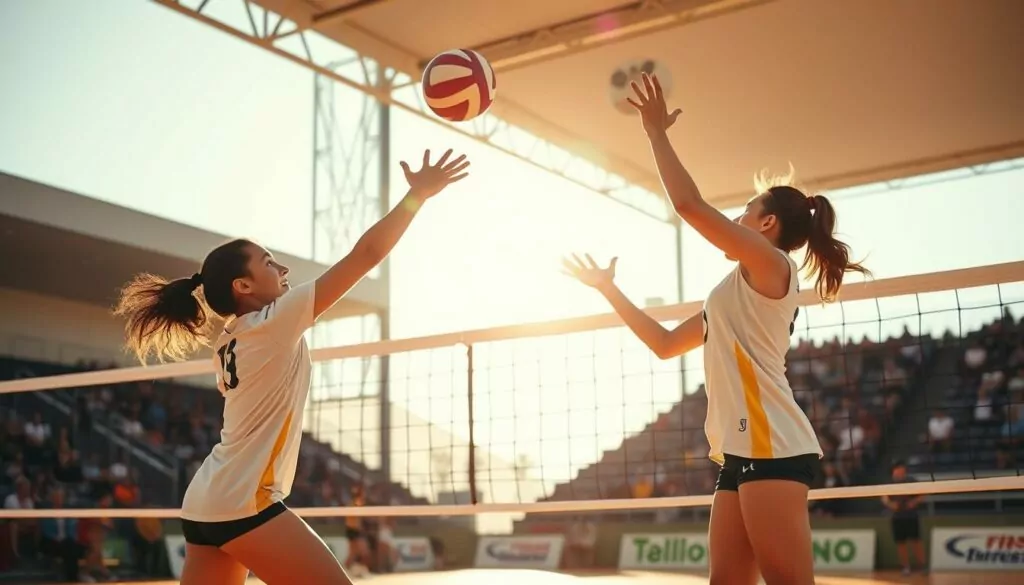
Setting is key to a team’s success in volleyball. As a setter, you need to work on your timing and precision. This helps you connect well with your hitter teammates. We’ll look at setting drills that improve these skills for you and your partner.
The Importance of Timing
Timing is critical in volleyball, and setting is no different. Drills that enhance your setting rhythm and sync with your partner are vital. They help you anticipate your partner’s moves and set the ball at the right time. This sets your hitters up for success.
Setting to Different Spots
Setters must be versatile, placing the ball in various spots to keep opponents guessing. Drills that challenge you to set to different areas improve your accuracy. This makes your team’s offense more unpredictable and dynamic.
Setting drills do more than boost your skills. They strengthen your partnership. By working together, you’ll anticipate each other’s moves and communicate better. This trust is essential for a successful volleyball partnership.
Improving Defense Through Drills
As a volleyball fan, I’ve learned that strong defense is key. I spend a lot of time on drills to improve our defensive skills. These drills help us dig the ball better and make smart defensive moves.
Partner Digging Techniques
The “Belly Drill” is a big part of our practice. It helps us react fast and defend the floor well. We’ve gotten better at working together, covering more ground.
We also focus on how to dig the ball right. Keeping our arms away and getting our hips under the ball quickly is key. This has made us better defenders and improved our teamwork.
Coordinated Defensive Moves
We do drills that test our teamwork in tough defensive situations. We face different types of attacks, from hard hits to deep shots. This makes us braver and more ready to defend.
These drills have made us a strong team. We can read each other’s moves and respond fast. This teamwork has made us better at stopping attacks.
“Defensive skills are the unsung heroes of volleyball. Mastering them as a team can unlock the true offense.”
Incorporating Movement in Drills
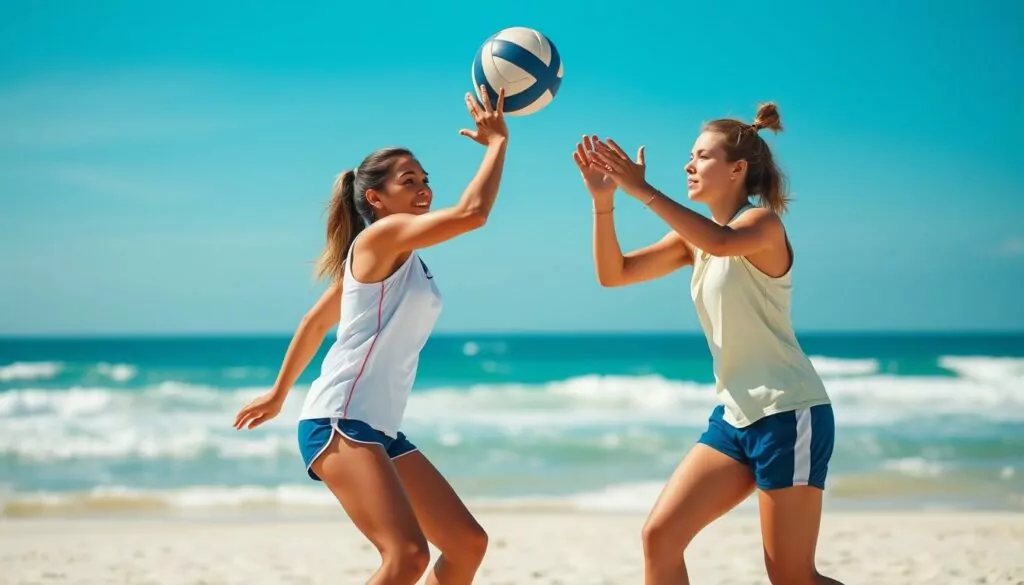
I’ve been coaching volleyball for over 20 years. I’ve learned how vital movement is in training. Volleyball demands agility, quickness, and coordination. Drills that focus on footwork and lateral movements can elevate your game.
Footwork Drill Patterns
The passing ladder drill is a favorite of mine. It tests players’ speed and passing stance as they move through cones. They should stay low, keep shoulders square, and use legs for power.
The passing and shuffling drill is also effective. Players pass the ball, then shuffle side-to-side before passing again. This drill sharpens reflexes and agility for quick position changes.
Side-to-Side Movement Exercises
Lateral movement is key in volleyball. The side-to-side blocking drill is great for this. Players practice sliding and jumping to block from various net positions. This improves court coverage and defense.
The tape targets drill also enhances side-to-side movements. Players jump and reach for targets on the floor, forcing quick direction changes.
Adding these drills to your practice will boost your players’ agility, footwork, and court awareness. Consistency is essential, so regularly revisit these exercises to solidify the skills.
Transition Drills for Game Readiness
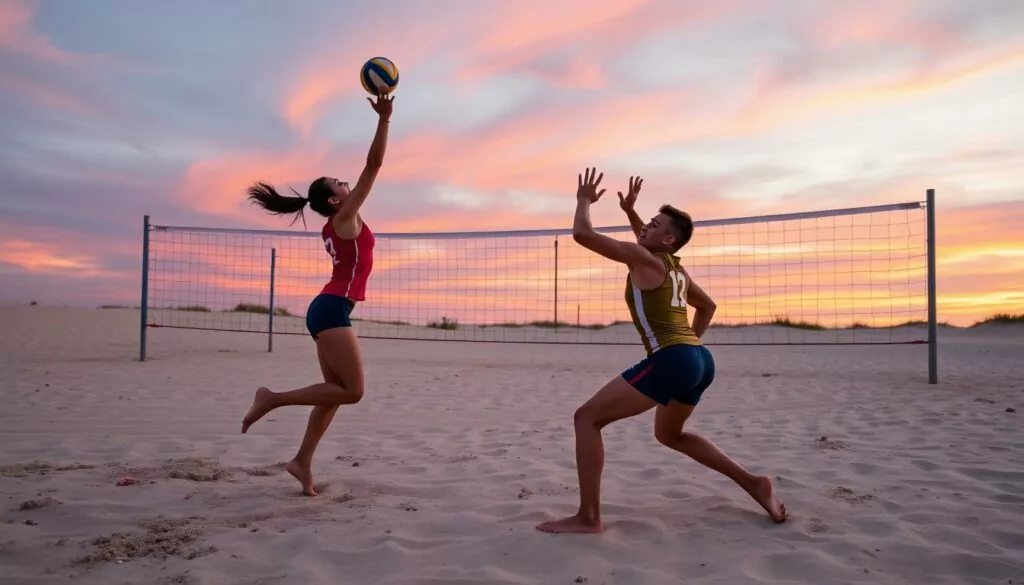
Volleyball is a fast-paced sport that needs players to be quick and flexible. It’s important to move smoothly from defense to offense and back again. Transition drills help players get better at this, making them ready for the fast pace of games.
Fast Break Transition Drills
Fast break drills mimic game situations where players must quickly change roles. These drills test how fast partners can react when the ball changes hands. They work on coordination and quick thinking under pressure. By doing collaborative volleyball routines, players get faster and more ready for the game.
Quick Reaction Drills
Quick reaction drills also focus on being fast. Volleyball partnership drills make players better at anticipating and acting on sudden ball movements. These two-person volleyball drills improve how well partners work together and adapt. They help players get better at reacting quickly in games.
Adding transition and quick reaction drills to your practice can really help. By getting good at these, you’ll be ready for the unpredictable nature of volleyball. You’ll do better on the court.
| Drill Type | Objectives | Duration | Players Required |
|---|---|---|---|
| Fast Break Transition Drill | Rapid switching of roles, improved coordination | 10-15 minutes | 2-4 players |
| Quick Reaction Drill | Enhanced reflexes, better adaptability | 12-18 minutes | 2-3 players |
“Transition drills are the key to unlocking your team’s full potentia on the volleyball court. By honing these skills, you’ll be ready to seize every opportunity and stay one step ahead of the competition.”
Serving Drills for Better Accuracy
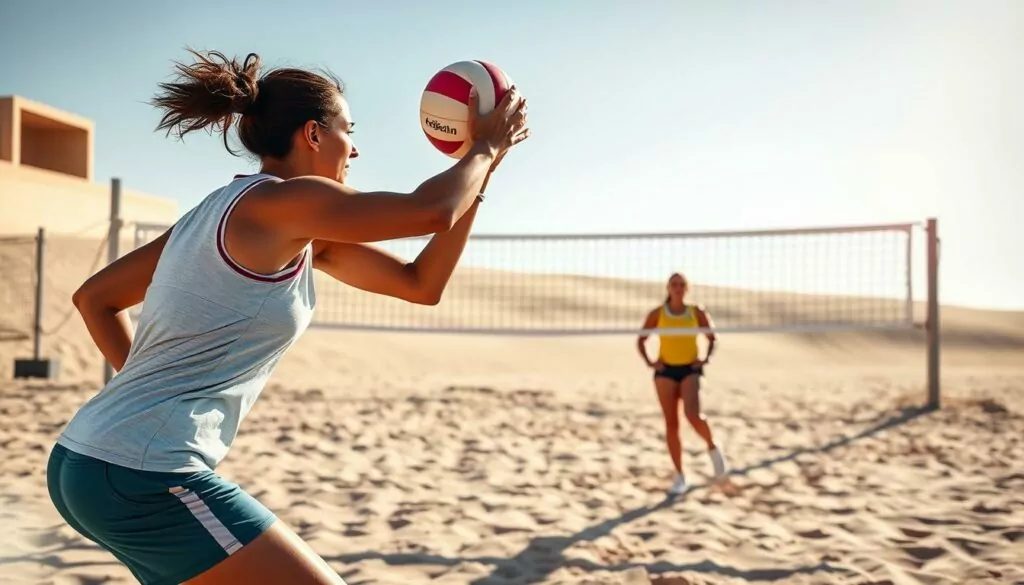
As a volleyball fan, I’ve learned serving drills are key for better accuracy. Serving is a skill that can really help your team. I’ll share some drills to improve your serving.
Partner Serving Routines
“Serving Around the World” is a great drill. It needs at least three players on the baseline. Each player serves to the opposite player, then digs and rolls the ball back. The team aims for 12 successful serves, changing positions after each round.
The “Crosscourt versus Down-the-Line” drill is also effective. Players alternate serving crosscourt and down-the-line. This drill helps improve precision and ball placement, key for winning matches.
Target Practice with a Friend
Target practice drills are also important. “X Marks the Spot” is one, where players serve to zones marked with an “X.” It helps hit targets consistently, which is vital for accuracy.
“Field Goal” is another drill. Players serve through a small space, simulating game precision. It focuses on technique, like a straight follow-through and solid contact with the ball.
Serving drills, with a partner or solo, are vital for volleyball players. They help improve accuracy and consistency. By adding these drills to your routine, you’ll become a better server and help your team win.
Advanced Drills for Experienced Players
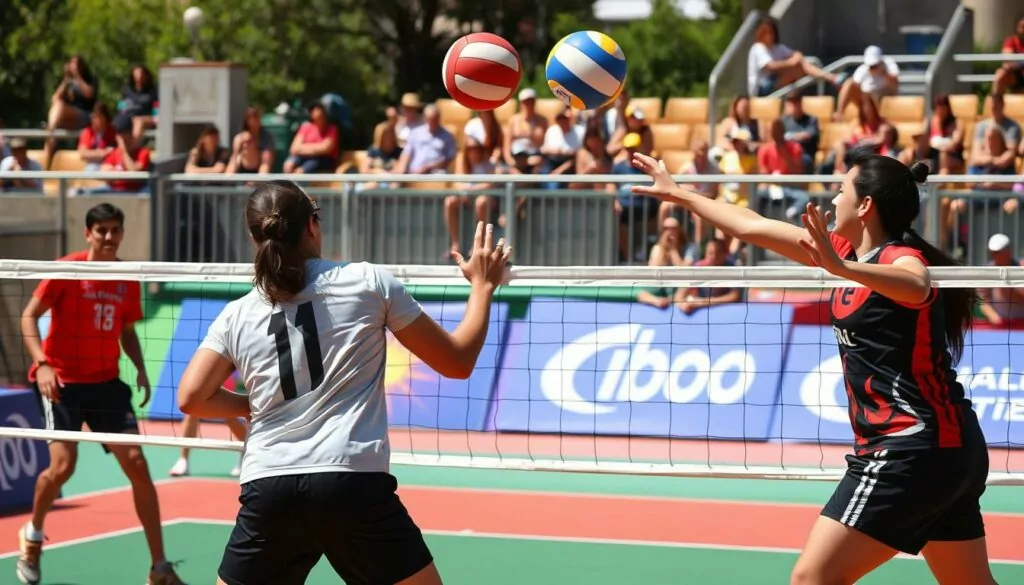
As volleyball players get better, they look for harder drills to improve. These volleyball teamwork exercises and tandem volleyball practice routines are for those who want to master complex strategies. They help players sharpen their volleyball duo training skills.
Complex Attack and Defense Scenarios
The “Queen of the Court” drill is a great example. It’s like a game that tests players’ back-row hitting and defense. They must make fast decisions and perform complex plays. This drill teaches players to understand the game better and work together smoothly.
Strategic Play Drills
Advanced drills also focus on making better strategic decisions. These strategic play drills set up tough scenarios that require players to guess their opponents’ moves. This way, experienced teams can improve their game reading, quick thinking, and teamwork.
| Drill Name | Description | Benefits |
|---|---|---|
| Queen of the Court | Played 3 on 3 with each team getting two contacts. Incorporates back-row hitting and defensive precision. | Develops sophisticated plays, court strategy, and coordination. |
| Bail Drill | Attack at one player at a time out of a single-file line. Challenges defensive reactions. | Improves defensive skills and decision-making under pressure. |
| Matrix Drill | Receiving team is battling the servers for three minutes straight. Tests endurance and concentration. | Builds mental toughness and game-like intensity. |
By adding these advanced drills to their training, experienced volleyball players can reach new heights. They’ll develop the skills and strategies needed to compete at the top level.
Endurance and Stamina Building Drills
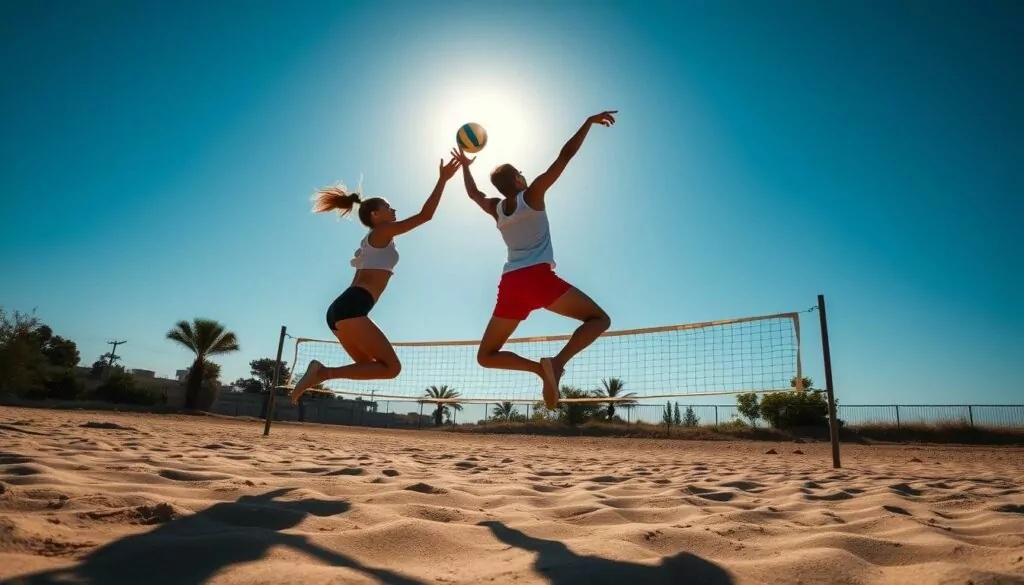
As a dedicated volleyball player, I know how key endurance and stamina are. Volleyball demands players to perform at their best from start to finish. My partner and I focus on drills that boost our endurance and stamina.
High-Intensity Partner Workouts
The “Run and Serve” exercise is a favorite of ours. It mixes sprinting with serving, keeping us intense and sharp. We sprint for 20-30 seconds, then serve the ball, doing this over and over. This drill boosts our heart health and keeps us focused, even when tired.
Continuous Movement Drills
We also do drills that keep us moving and focused. These include side-to-side movements and drills that keep our intensity up. These exercises help us last longer on the court, which is key for success in volleyball.
Working together on endurance drills has really helped us. We push each other to do better and stay motivated. These drills have made us stronger and more resilient players.
Using Technology to Enhance Practice
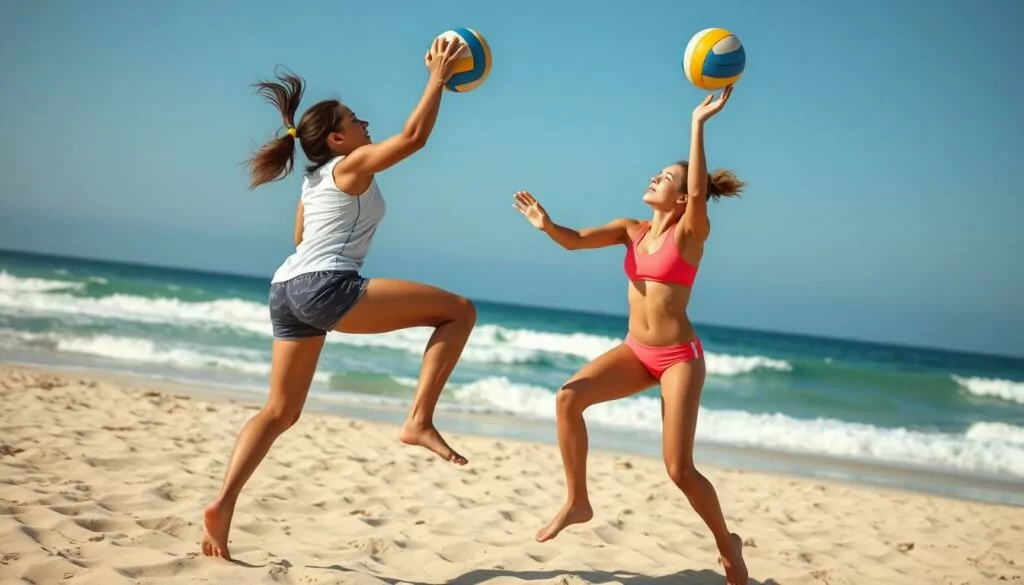
Technology has changed the game for volleyball players and coaches. It makes partnership drills and training better. This leads to real improvements on the court.
Video Analysis of Drills
Video analysis is a powerful tool. It lets us review our drills and see what we need to work on. Apps like VolleyMetrics help us understand our game better.
Apps for Tracking Improvement
Technology also helps us track our progress. Apps like Balltime use AI to analyze our videos. They help us see how we’re improving and make better decisions.
Technology is key for better sports training. It lets us easily access our performance data. This helps us improve our training together.
Using technology, we can take our drills to the next level. It helps us grow faster and become a stronger team on the court.
Setting Up a Practice Schedule with a Partner
Creating a set practice schedule is key for volleyball players wanting to get better. When you train with a partner, plan your sessions well. This ensures you work on all game aspects, like passing, setting, hitting, and serving.
Setting clear goals and checking your progress often keeps you motivated. This helps you stay focused on what you both want to achieve.
Planning for Progress
Begin by setting aside time for different training parts. For instance, start with 10 minutes of warm-up drills. Then, spend 20 minutes on passing and setting, 15 minutes on hitting and serving, and 15 minutes on game-like scenarios and feedback.
This plan makes sure you cover all key skills. It also gives time for personal coaching and making adjustments.
Keeping Motivated Together
Training with a partner boosts your tandem volleyball practice and keeps you motivated. Set goals you can reach, like bettering your serve or mastering a new setting move. Track your progress together and celebrate small victories.
Give each other feedback that helps improve. This creates a positive, supportive environment for ongoing growth.
| Time | Activity | Duration |
|---|---|---|
| 6:00 – 6:02 pm | Warm-up (Jogging and Huddle) | 2 minutes |
| 6:02 – 6:12 pm | Downball Game | 10 minutes |
| 6:12 – 6:13 pm | Water Break | 1 minute |
| 6:13 – 6:23 pm | Serving Progressions and Individual Coaching | 10 minutes |
| 6:23 – 6:33 pm | Around the World Competition Edition | 10 minutes |
| 6:33 – 6:43 pm | Passing Drills | 10 minutes |
| 6:43 – 6:53 pm | Choice Drill (Scrimmage, Queen of the Court, or Freeball/Downball) | 10 minutes |
| 6:53 – 6:58 pm | Wrap-up and Information Dissemination | 5 minutes |
By sticking to this plan, you and your partner can improve your volleyball teamwork exercises and volleyball duo training. You’ll stay motivated and focused on your goals.
Creating Fun Competitive Drills
Adding competition to volleyball drills makes them more exciting. It feels like a real game. Players work on their skills and learn to work together.
Game-Like Scenarios
The “3-2-1-0” drill is thrilling. Players get points for their kills. A kill is worth 3 points, a tip 2, a dink 1, and a miss 0.
This makes players be quick and decisive. It’s like being in a tight game.
Score-Based Drills
“Hit the Deck” is a challenging drill. Players must quickly return serves or sets. If they fail, they hit the floor.
This drill improves skills and teamwork. It makes players better and closer as a team. They learn to support each other.
Feedback Mechanisms in Partnership Drills
In volleyball, giving good feedback is key to getting better with your partner. When you’re working together, knowing how to give helpful advice is very important.
Constructive Criticism Techniques
When you give feedback, be specific and clear. Don’t just say “Good job!” or “You need to do better.” Instead, tell your partner exactly how they can get better. For example, you could say, “Your approach step was a bit slow on that last spike. Try to take a quicker first step to hit harder.”
This kind of feedback helps your partner know exactly what to work on.
Celebrating Small Wins
It’s also important to celebrate the small victories. Acknowledge any small successes, like a perfect set or a great serve. This keeps the training positive and shows you’re making progress together.
By giving good feedback and celebrating together, you’ll improve your game even more. Remember, the journey is just as important as reaching the goal. Enjoy the time you spend practicing together.
| Drill | Description | Benefits |
|---|---|---|
| Short Court Scramble | A high-intensity game played on a smaller court, typically involving at least six players per side. | Improves reaction time, communication, and teamwork. |
| Around the World Passing | A drill designed for 8-12 players, where they quickly pass the ball around the perimeter of the court. | Enhances passing accuracy, coordination, and endurance. |
| No Mistakes SR Game | A game played to 15 points, where teams only score on positive plays like kills, aces, or terminating blocks. | Fosters consistent, error-free execution and strategic thinking. |
“The key to successful partnership drills is finding the right balance between constructive feedback and celebratory moments. This synergy helps create an environment where both players feel motivated to improve and supported in their journey.”
Keeping the Energy Up During Drills
Keeping the energy high during volleyball practice is key for skill growth and teamwork. Fun warm-ups and engaging activities after drills make our collaborative volleyball routines fun for everyone.
Fun Warm-Up Routines
I start with a “Dynamic Warmup” drill to get everyone moving. We do arm circles, leg swings, and lateral shuffles. This gets the blood flowing and muscles ready for a great practice.
Engaging Post-Drill Activities
After our volleyball teamwork exercises, we do something fun to cool down. It might be “Knockout” or the “Volleyball Trivia Challenge.” These activities boost team spirit and keep everyone’s energy up.
By focusing on fun warm-ups and cool-downs, I keep my players excited and motivated. They stay focused and ready for the next challenge.
Adapting Drills for All Skill Levels
Creating effective volleyball drills for different skill levels is key. As a coach with over 20 years of experience, I’ve found that a one-size-fits-all approach doesn’t work. It’s important to tailor volleyball duo training to each player’s needs.
Beginner-Friendly Modifications
New players need to focus on the basics. Drills like the “Snap Drill” for hitting help them learn proper form. By using controlled tosses instead of player serves, you can make sure the ball is placed right for practice.
Varsity Level Challenges
For more experienced players, you need to challenge them. Drills like the “Matrix Drill” improve their decision-making and precision. These drills are fast-paced and require quick thinking and teamwork.
It’s important to balance the difficulty levels for all players. By grouping them based on skill, you can make sure everyone is challenged and supported. This helps them grow and improve together.
The goal is to make sure all players feel empowered to grow and succeed. With the right adaptations and attention to individual needs, you can help your volleyball duo training thrive. This creates a strong, cohesive team.
The Role of Mental Preparation in Drills
In volleyball, mental preparation is as important as physical skills. When we explore two-person drills, partner exercises, and team training, mental focus is key. Visualization and focus can greatly improve your team’s performance.
Visualization Techniques
Visualization helps volleyball partners practice mentally. They imagine making perfect passes and setting with accuracy. This mental practice boosts skills and confidence, working well with physical drills.
Staying Focused and Positive
Keeping a sharp focus and positive attitude is vital during practice. Partners who focus on one point at a time can overcome challenges. This mindset strengthens the team and prepares them for competition.
Using visualization and staying focused can unlock your team’s full strength. These mental strategies, along with physical drills, make a strong partnership on the court.
“Mental toughness is essential for volleyball players, allowing them to withstand the pressures of competition and reach their full potentia on the court.”
As we explore volleyball drills, remember the importance of mental preparation. Embracing these strategies can lead to better performance and strong team bonds.
Conclusion: My Journey with Partnership Drills
Reflecting on my time with volleyball partnership drills, I’m amazed at my growth. These exercises have boosted my skills and strengthened my bond with teammates. We’ve learned to trust, communicate, and make decisions together, making our game better.
Reflecting on Growth and Improvements
Team dinners at the University of Exeter Women’s volleyball team in 2013-14 showed the importance of team bonds. My partner and I have also grown by mentoring and doing community service. We’ve learned to handle conflicts and improve our communication through workshops and talks.
Future Drills to Explore
I’m looking forward to trying more advanced drills. VolleyballXL’s resources have inspired us to keep improving. With more coaches and trainers joining, I’m excited to see what new challenges we’ll face. I’m ready to keep up with the sport’s changes.
